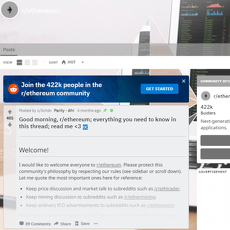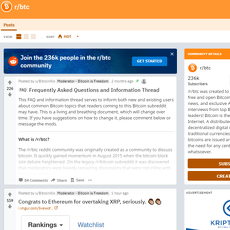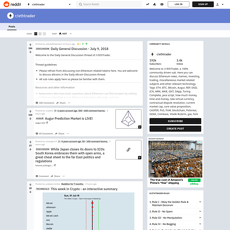r/CryptoCurrencyTrading Review
r/CryptoCurrencyTrading
www.reddit.com
r/CryptoCurrencyTrading Review Guide: Everything You Need to Know (With FAQ)
Ever scroll Reddit for crypto tips and feel like you’re drowning in noise? You’re not alone. I’ve spent years hunting for signal, and r/CryptoCurrencyTrading is one of the rare places where traders actually talk shop—setups, risk, and process—without the endless pump-and-dump circus.
In this guide, I’ll show you how to use that subreddit the right way so you learn faster, stay safe, and don’t waste time on low-quality posts. You’ll see what gets engagement (and what gets removed), where the best discussions happen, and how to set realistic expectations before you post or trade.
Why Reddit can be frustrating for traders
Most trading forums suffer from the same traps. If you’ve felt any of these, you’re in the right place:
- Contradictory advice everywhere — one “guru” says long, another says short, both cherry-pick screenshots.
- Signals and paid groups — posts pushing DMs, VIP rooms, or “managed accounts” (classic red flags).
- Hype over process — tons of “100x soon” claims, very few posts that show a plan, invalidation, or risk controls.
- Time sink — an hour of scrolling with nothing actionable to show for it.
There’s also a behavioral angle worth noting. Research on retail traders shows we’re drawn to attention-grabbing content, even when it’s not useful. In stocks, for example, Barber & Odean’s work on attention-driven buying found that flashy headlines skew investor behavior. Crypto is even faster and louder, which is why a community with solid moderation and clear rules matters.
“If a post can’t explain the thesis, risk, and what invalidates the idea, it’s entertainment—not trading.”
What you’ll get from this guide
I’ll make r/CryptoCurrencyTrading simple to navigate by breaking down:
- What the subreddit is (and isn’t) — so you know what to expect before you jump in.
- How to find high-quality content fast — threads, flairs, sorting, and search tricks.
- Posting that gets real feedback — formats that survive automod and attract smart comments.
- Safety essentials — scam filters, risk basics, and practical tax notes.
- Realistic expectations + FAQ — straight answers to the questions everyone asks.
Who this is for
- New traders who want a focused way to learn market structure, journaling, and risk without chasing hype.
- Intermediate traders refining entries/exits and looking for feedback on strategy, not signals.
- Anyone who values proof, transparency, and process over promises.
What this means for your time
Used well, r/CryptoCurrencyTrading can compress your learning curve. For example:
- Instead of a “to the moon” thread, you’ll find a BTC 4H chart with entries, invalidation at a prior swing low, confluence from a 200 EMA and daily level, and a defined R:R. That’s a post you can learn from.
- Instead of a cropped PnL brag, you’ll see a strategy breakdown with a ruleset, recent trades, and a journal snippet. That’s actionable.
Those are the posts we’ll surface quickly—and the kind of content you’ll learn to create to get useful feedback.
Quick disclaimer
Nothing here is financial or tax advice. Trading is risky. Use paper trading and risk controls, and always do your own research. Keep records if you care about taxes, and talk to a professional in your region.
Ready to cut the noise and find the good stuff on r/CryptoCurrencyTrading? Next up, I’ll show you exactly what the community is—and what it isn’t—so you don’t go in with the wrong expectations. Want the full breakdown as it’s released? Keep an eye on Cryptolinks News.
What r/CryptoCurrencyTrading is (and isn’t)
r/CryptoCurrencyTrading is a trading-first subreddit where people talk charts, risk, and process. It’s not a signals factory, not a pump room, and not the place to drop your Telegram handle. Think of it as a roundtable for traders who prefer evidence over ego.
“Skills pay bills. Signals rent your attention.”
If you’ve been burned by hypey rooms, this space feels like a reset button. Threads tend to reward clarity, screenshots, and logic. Empty bravado gets little traction, and outright shilling gets removed fast.
The basics at a glance
- Scale and pace: A large, active community with new posts and comments landing every few minutes during market hours. Expect the feed to speed up around CPI, FOMC, and big BTC moves.
- Who hangs out: A mix of day traders, swing traders, and options/derivatives folks. You’ll also see beginners asking smart questions and a handful of pros who pop in with clean, checklist-style frameworks.
- When it’s busiest: U.S. and EU sessions are the most active. If BTC is trending hard, you’ll see Asia hours light up too.
- Tone: Analytical and pragmatic. Posts that state a thesis, show invalidation, and respect risk get the most engagement.
House rules and culture
- No paid signals or promos: Anything pushing VIP groups, managed accounts, or “guaranteed gains” is removed. You’ll notice Automod catching Telegram handles, WhatsApp numbers, and referral-heavy posts.
- Proof and transparency: If you claim you caught a move, expect people to ask for a chart, execution details, or a trackable idea. Screenshots with order IDs (personal info hidden) go a long way.
- Low-effort = low reach: One-liners, meme-only market takes, or “X to the moon?” posts usually get filtered or ignored.
- Active moderation: Mods and Automod enforce the rules consistently. That’s not just about neatness—research on online communities shows consistent moderation improves discussion quality and reduces spam. See: Matias (2019) and Chandrasekharan et al. (2017).
What you’ll see daily
- Technical Analysis (TA) with charts: Marked-up levels, trendlines, liquidity zones, and notes like “Invalidation: close below 1H EMA200.” Good posts often include a timeframe stack (e.g., 1D context, 4H setup, 1H trigger).
- Market structure talk: Discussions about higher highs/lows, range rotations, and “where liquidity likely sits” around prior weekly highs/lows.
- Derivatives and funding: Threads on funding rates, open interest, liquidation heatmaps, and how to avoid getting chopped on perp moves.
- Exchange and broker news: Outage reports, fee changes, KYC notes, and platform risk reminders when volatility spikes.
- Beginner Q&A: Fresh questions on stop placement, position sizing, and what a clean invalidation looks like—often answered with screenshots and rules-of-thumb.
- Macro moments: Short, timely posts: “CPI in 2 hours—watch DXY and yields for risk tone.” Not macro theory, just what matters for today’s trades.
Sample thread titles you’ll recognize:
- “BTC 4H breakout retest—looking for S/R flip. Invalidation below last swing low.”
- “Funding + OI spiking into range highs. Caution on late longs.”
- “New to risk: is 1% per trade too much for a 40% win rate system?”
How it compares to other trading subs
- Less noise: Fewer memes and fewer “When Lambo?” type comments. It’s not anti-humor—just not the focus.
- More strategy, less cheerleading: You’ll see structured posts rather than blind price calls. “Here’s the setup, here’s the invalidation” beats “XRP to $10?” every time.
- Stricter on low-effort: Link-drop YouTube “alpha,” referral fishing, or hype-y TA with no context tends to vanish.
- Scope: It’s about trading crypto. Not a place for broad macro essays, NFT shills, or token marketing campaigns.
Why that matters
Attention is your scarcest resource. A cleaner feed means less cognitive overload and better decisions. That’s not just a feeling—time after time, data shows most short-term traders lose money, especially when chasing noise. The Brazilian securities regulator analyzed day traders and found only a sliver made consistent profits after fees; over 97% lost money across 300 days (CVM study). Environments that push you toward process—and away from “get rich fast”—help you stay on the right side of that statistic.
Here, good posts earn attention. Bad habits get checked. And when you share something with a clear plan, people actually respond with useful feedback. That culture is the edge.
Want to skip the scrolling and surface the best ideas in under 60 seconds? In the next section, I’ll show you the exact threads, flairs, and search tricks I use to find A+ content fast. Which filter would you try first if it cut your feed quality problems in half?
Find the good stuff fast: threads, flairs, and search
Scrolling isn’t strategy. The right filters turn Reddit from a time sink into a toolbox. Here’s exactly how I pull signal from r/CryptoCurrencyTrading in minutes, not hours.
“Don’t read everything. Read the 5% that changes how you trade.”
Daily/weekly threads to watch
I start my day in the routine community threads. They pack the highest “smart comment per minute” ratio—quick context, clean setups, and risk talk from people who actually track their trades.
- Daily Market Threads: Snapshot of what’s moving, funding flips, and intraday levels. I often catch useful notes like, “ETH perp funding turned positive after Asia open—watch for squeeze into H4 supply.”
- Weekly Q&A / Newbie Help: Great for clarifying ideas without noise. Expect questions like “Where should invalidation sit on a trend pullback?” and answers that show the math (e.g., ATR-based stops).
- Strategy/TA Roundups: Roundup posts where traders share frameworks, not just arrows—things like a simple playbook: “Only take H1 trend-continuation when D1 is aligned and funding supportive.”
Real example I’ve bookmarked from a weekly thread: “Stop distance = 1.5x ATR(14) on entry timeframe; size = risk $ / stop distance.” It’s basic—and incredibly effective when you actually use it.
Use flairs and sorting
When I’m short on time, I only view posts that earn their place:
- Flairs to filter: Strategy, Technical Analysis, Education, and Question (for learning threads). Skip anything that screams promo.
- Sort by Top → All time: Timeless lessons (risk frameworks, journaling templates, setup rules). These are your “save and reread” posts.
- Top → This month/This week: Active market context and current market structure notes that still have shelf life.
- New: Fresh setups and evolving discussions. I use this when I have a clear plan and want extra color, not when I’m hunting for a strategy.
Workflow I use: Flair: Education + Sort: Top (Past Year) → I skim titles for process-oriented posts: backtests, checklists, journaling—anything that survives across market cycles.
Search like a pro
Good search beats endless scrolling. I use two methods:
1) Google style: Fast and precise.
- site:reddit.com/r/CryptoCurrencyTrading “stop loss” ATR
- site:reddit.com/r/CryptoCurrencyTrading ETH “funding rate” OR “open interest”
- site:reddit.com/r/CryptoCurrencyTrading “risk to reward” checklist
- site:reddit.com/r/CryptoCurrencyTrading “position sizing” -meme -giveaway
2) Reddit’s built-in search: Search a term, then set Community to the subreddit, Flair to Education/Strategy, and adjust Time to Past Year for relevance.
Queries that consistently pay off for me:
- “ATR stop” for practical stop placement rules
- “R multiple” for risk-to-reward discussions and examples
- “funding + basis” for derivatives context when perps feel crowded
- “break of structure H4” for clean market structure visuals
UX research backs this up: targeted search and filtering dramatically cuts cognitive load and time-to-answer. If you’re curious, check out Nielsen Norman Group’s guidance on search vs. navigation—it mirrors what works on Reddit too.
Bookmark and save
I treat Reddit like a mini knowledge base:
- Save posts that contain frameworks, not predictions: risk templates, journaling formats, and checklists.
- Create a custom feed (multireddit) for trading subs and sort by Top weekly—helps you catch lessons you missed.
- On desktop, use Reddit Enhancement Suite (RES) to tag and note saved posts. I add notes like “Use after 2R rule” or “Only during high vol.”
- Make a quick pre-session routine: open your saved “Education/Strategy” posts and skim before charts. It sets your brain to process mode, not chase mode.
What I save most often: posts that show before and after—the thesis, the invalidation, the outcome, and the lesson. That feedback loop is gold.
Desktop vs. mobile tips
I love mobile for quick checks, but real learning happens on a bigger screen.
- Desktop: Filter by flair faster, open chart images full resolution, and compare multiple posts side-by-side. I also keep TradingView open to test ideas immediately.
- Old Reddit view: Cleaner threading and flair filters. Bookmark it for browsing analysis posts.
- Mobile: Great for reading comment highlights and saving posts to process later. I avoid making final trading decisions from my phone.
A tiny habit that compounds: when you save a post, add a one-line takeaway in a note app—“ATR 1.5x stop + 2R take profit works best on H1 trend days.” Reviewing these bites before a session keeps you consistent.
Now that you can find A+ posts in seconds, want to know how to write one that gets real feedback (and avoids automod headaches)? You’ll see the exact template I use next—how would your last chart look if you added a clear invalidation and R:R upfront?
Posting that gets engagement (and survives automod)
Want real feedback instead of crickets or removals? Strong posts on r/CryptoCurrencyTrading share a clear plan, receipts (charts), and realistic risk. The mods reward structure and transparency; the community rewards curiosity. That’s your edge.
“If you can’t explain your trade in two sentences, you don’t have a trade—you have a wish.”
The perfect post template
Use this as your copy/paste baseline. It hits everything mods and traders look for:
- Pair + timeframe: e.g., BTC/USDT, 4H (Binance futures)
- Thesis: What you think is happening and why (structure, level, catalyst)
- Invalidation: Exact price/condition that kills the idea
- Risk-to-reward (R:R): Your target vs. stop, e.g., 1:2
- Plan: Entry trigger, position size logic, partials, conditions to stand down
- Chart: Clear screenshot with levels labeled, no clutter
- Ask: One specific thing you want feedback on
Example title: “ETH/USDT 4H – Retest of 2,520 supply; invalidation 2,565; R:R 1:2.1. Looking for confluence flaws.”
Example body (short):
- Thesis: Lower high after H4 market structure shift. Short on retest of prior H4 supply at 2,520 with confluence: 0.618 retrace + 200 EMA overhead.
- Invalidation: Close above 2,565 (breaks lower-high thesis).
- R:R: 1:2.1 to 2,430; extended 1:3 to 2,385 if momentum holds.
- Plan: Limit at 2,515 with 0.5% risk. If H1 prints strong bullish engulfing into zone, I stand down.
- Ask: Is my invalidation too tight for current H4 ATR? Would you anchor to H1 swing instead?
Why this works: it’s specific, falsifiable, and easy to critique. Research on web usability (NN/g) shows structured, scannable posts get more engagement—same principle here: give readers hooks to respond to.
Chart etiquette
Messy charts and mystery arrows get flagged or ignored. Keep it simple:
- Label everything: Timeframe, exchange, tool names (EMA200, VWAP, OBV, fib levels).
- Mark entries/exits: Use different colors and put prices next to them for clarity.
- Show confluence: Horizontal level + trendline + indicator context beats single-signal posts.
- State invalidation on the chart: A red line with “Invalidation 2,565 (H4 close).” This reduces hindsight bias and invites better feedback.
- One timeframe per image: If you need multi-timeframe context, use a second image or a two-panel collage—don’t cram.
- Crop the noise: Hide watchlists and chat boxes. Native Reddit image uploads tend to be safer than off-site links.
Pro tip: uncertainty signals intelligence. Phrases like “If X then Y; else I stand down” show you have a decision tree, not a prediction. Posts that acknowledge uncertainty tend to get more thoughtful comments.
No signals, no promos
Mods are strict for good reason. Skip these entirely:
- “DM me for VIP signals/Discord”
- Referral links, affiliate codes, “managed accounts”
- “100% win rate strategy” or anything implying guaranteed returns
Even asking for paid signals can get your post removed. If you want feedback, post your plan publicly with proof. If you need a trading buddy, ask for accountability partners, not DMs.
Commenting tips
Want comments that actually help you trade better? Make it easy for people to engage:
- Be specific: “Is my invalidation logical for current H4 volatility?” is better than “Thoughts?”
- Show your work: Summarize your backtest or why you use that setup.
- Share what you tried: “I tested this on 30 trades; R:R averaged 1:1.7, win rate 42%. What’s missing?”
- Be coachable: A thank-you and a follow-up edit signals you’re serious, which invites more help.
If you disagree, focus on the setup, not the person. You’re building reputation capital, not just karma.
Common reasons posts get removed
- Low-effort: One-line predictions, meme charts, “10x soon??”
- Link-only: Posting a YouTube/Twitter link without a summary or chart
- Referrals/affiliates: Any promo or invite that benefits you
- Unverifiable claims: “Turned $500 into $50k in a month”—no proof, no post
- Wrong flair/format: Not tagging as “Technical Analysis,” no timeframe/pair in title
If you’re unsure whether automod ate your post, check Reveddit and review Automoderator rules. A quick edit to add missing context can often get it approved.
Karma and account age realities
Brand-new accounts with zero karma are more likely to be filtered. It’s nothing personal—it’s spam defense.
- Warm up first: Comment thoughtfully on a few daily threads. Upvotes from useful replies build trust.
- Avoid link dumps: Post native text plus charts. External links trigger filters more often.
- Use the right flair: “Strategy,” “Technical Analysis,” “Question,” or “Education.” Flair misfires look spammy.
- Proof helps: If you mention a backtest, include a screenshot or a short methodology summary.
Think of karma as your cost of entry. A little give before you ask goes a long way.
Quick checklist before you hit Post:
- Does your title include pair, timeframe, and your plan focus?
- Do you clearly show invalidation and R:R?
- Is your chart readable on mobile?
- Did you ask one pointed question?
- Did you remove any promos, ref links, or DMs invites?
It’s amazing how many headaches vanish when your post reads like a trade plan instead of a prediction. That one shift also protects you from overconfidence—something behavioral research has warned traders about for decades.
One last thing before you hit that submit button: what’s the fastest way to get banned and lose money at the same time? It starts in the DMs. Ready to protect your attention, your wallet, and your sanity in the next section?
Stay safe: scams, risk, and taxes
Trading crypto is exciting, but bad actors and bad habits will drain your account faster than a wick through a stop. Keep your wallet, attention, and energy protected so you can actually learn and trade well.
DMs and “paid group” traps
Scammers prey on urgency, ego, and loneliness. If you post a chart or question, you’re on their radar. Common tactics I regularly see:
- “VIP signals” and managed accounts: “We made 400% last week, want in?” They’ll ask for “test capital” and disappear. Never send funds to anyone managing money via Telegram/Discord.
- Impersonating mods or reputable traders: Slightly misspelled names, stolen avatars, and fake “verification” screenshots.
- “Recovery experts” after a hack: They promise to get funds back for a fee. This doubles the loss.
- Giveaway bots: “You won! Pay a small network fee to claim.” That “fee” is the scam.
Quick sniff test you can run in 10 seconds:
- Unsolicited DM? Block + report.
- Asks for seed phrase, 2FA codes, or remote access? Non-starter. No legit admin needs this. Ever.
- Pressure + urgency? Real opportunities don’t need you to act right now.
Worth knowing: investment scams are the largest category of crypto crime by revenue, year after year, according to multiple reports like Chainalysis Crypto Crime. Protect your DMs like you protect your private keys.
“Amateurs think about how much they can make; professionals think about how much they can lose.”
Risk management basics
One great setup won’t save a reckless risk plan, but a decent setup with excellent risk rules can carry you a long time. My non-negotiables:
- Risk per trade: 0.25%–1.0% of account. If your equity is $5,000 and you risk 1%, you’re risking $50 per trade.
- Position sizing formula: Position size = (Account × Risk%) ÷ Stop distance. Example: $5,000 × 1% ÷ 2% stop = $2,500 position. Leverage doesn’t change risk—your stop does.
- Max daily loss: Stop at −2R or after 3 losing trades. Review, don’t revenge-trade.
- Stop placement: Use structure (swing high/low), volatility (ATR), or both. If your stop is arbitrary, your risk is imaginary.
- Weekly circuit breaker: At −6R to −8R, stand down and audit your journal.
Reality check: regulators routinely disclose that 70–80% of retail CFD traders lose money. Crypto volatility magnifies that. A tight, boring risk plan beats “hero” trades nine days out of ten.
Paper trade before you size up
Before risking real money, score your process on paper or with tiny size. Keep it brutally simple:
- Journal fields: Date, pair, timeframe, setup type, entry/stop/target, R multiple, result, a 1–2 line note (what worked, what didn’t).
- Expectancy (quick math): E = (Average Win × Win Rate) − (Average Loss × Loss Rate). Positive E over 30–50 trades is a green light to size up slowly.
- Tools: TradingView’s paper trading is fine for starters. A basic spreadsheet beats no journal. Fancy comes later.
If your plan can’t win on paper, adding leverage won’t save it.
Exchange and wallet security
Good OPSEC turns “I wish I’d…” into “Glad I did.” Do this now:
- 2FA the right way: Use an authenticator app or hardware key (WebAuthn), not SMS. Save backup codes offline.
- Withdrawal allowlist: Lock withdrawals to your known addresses. Add a time delay for new addresses if available.
- Self-custody long-term holdings: Hardware wallet (bought direct), strong PIN, hidden passphrase, and an offline seed backup. Test with a small send first.
- Separate email: One clean email just for exchanges. Unique, long passwords. Consider a password manager and security keys.
- Carrier lock: SIM-swap protection with your mobile provider; remove phone numbers from account recovery where possible.
- Anti-phishing: Set an anti-phishing code on supported exchanges. Bookmark login URLs; never click “support” links from DMs.
- API keys: If you must use them, set read-only for analytics. No withdrawals, tight IP restrictions.
Leave only what you need for active trades on exchanges. Everything else should live in cold storage.
Tax notes and the 30-day rule
Taxes aren’t exciting until a letter shows up. Keep clean records and know the basics for your region.
- United States: The stock “wash sale” rule (30 days) under IRC §1091 applies to stocks and securities. As of now, most guidance says it doesn’t apply to crypto, which is treated as property—but that can change. Keep impeccable records and avoid transparent loss-harvesting “in-and-out” patterns that could trigger anti-abuse doctrines. The IRS also states staking rewards are taxable income when you have control of them. Start with the IRS Digital Assets hub: irs.gov/digital-assets.
- United Kingdom: HMRC’s share-matching rules, including the 30-day “bed and breakfast” rule, do apply to crypto assets. See HMRC guidance: gov.uk.
- Canada: The CRA’s superficial loss rule (30 days) can apply to crypto disposals. Check CRA guidance: canada.ca.
- Australia: The ATO treats crypto as property for CGT; “wash sale” behavior can be challenged under anti-avoidance rules. ATO guidance: ato.gov.au.
What helps everywhere:
- Record everything: Dates, amounts, wallet addresses, fees, fair market value at the time of each trade. Export CSVs regularly.
- Cost basis methods: FIFO, LIFO, or Specific Identification (e.g., HIFO). Pick one consistently and document it.
- Income vs. gains: Staking/airdrop yields are typically income on receipt; trading profits are capital gains/losses. Treat them separately in your records.
Jurisdiction matters
Laws vary wildly. Leverage caps, derivatives access, tax treatment, and reporting obligations differ by country. When you ask questions in the subreddit, always state your region so replies are relevant. If you want clarity on realistic income targets or what “safe” even means in crypto, you’ll want the next part—so tell me, what’s the number you’re chasing right now, and what are you risking to hit it?
Realistic expectations + FAQ
I get these questions constantly—from people who’ve been lurking for months to folks who just opened their first chart. Let’s set grounded expectations so you don’t burn time, attention, or capital chasing fantasy targets.
Can you make $1000 a day trading crypto?
It’s possible, but rare and unstable for most traders. To net $1000/day with sane risk, you either need meaningful capital or unusually high skill (and discipline) that you can repeat through different market regimes.
- Capital math: If you aim for ~1% per day on average (already aggressive), you need ~$100,000 to gross $1,000. Most traders can’t sustain 1% daily without dangerous leverage or overtrading.
- Variance is brutal: Even pros see streaks and drawdowns. A week of red can erase several “$1k days.” Planning around a fixed daily dollar target tends to push bad behavior.
- Evidence check: Regulators around the world report that the majority of retail derivatives traders lose money (typical broker disclosures show 70–80% lose). In equities, research like Barber & Odean’s “Trading Is Hazardous to Your Wealth” found that frequent traders underperform—overtrading is the common killer.
What works better: anchor to risk, not dollars. For example, if your account is $50k and you risk 0.5% per trade ($250), a good day might be +2R = +$500. Some days you’ll take -1R or -2R. Focus on consistency and drawdown control, not a number that pressures you to force trades.
Can I make $100 a day?
Maybe—but chasing that number usually backfires. You need enough capital and a system with positive expectancy. Here’s a cleaner way to think about it:
- Risk per trade: $25 risk (0.5% on a $5k account) with an average of +1R per day (not easy) would roughly hit $25/day. To stretch to $100, you’d need either more R, more size, or more trades—each adds volatility and mental stress.
- Better target: pick a weekly or monthly R goal and a max daily loss (e.g., -2R). That interrupts tilt and preserves your mental capital.
Reminder: “Make $X per day” is a trap. Trade the process, not the PnL.
What is the 30-day rule in crypto?
The classic stock “wash sale” rule (30 days) is designed to limit tax-loss harvesting in securities. As of now in the U.S., most guidance says it doesn’t apply to crypto because the IRS treats crypto as property, not a security. That said, rules evolve and other anti-abuse doctrines can still bite you.
- Keep records: timestamps, cost basis, wallets/exchanges, and fees.
- Talk to a tax pro: especially if you’re doing frequent trades or moving across chains and venues.
- Note your region: if you ask the community for help, say where you live—tax rules vary widely.
Bottom line: Don’t build a strategy around tax loopholes. Build a repeatable strategy and keep clean records, then optimize legally with a professional.
What is the safest cryptocurrency?
There is no safe crypto. There are only degrees of risk.
- Large caps like BTC and ETH tend to have deeper liquidity, more robust infrastructure, and fewer existential risks than microcaps—but both have seen -70% to -85% drawdowns in past cycles.
- Stablecoins remove price swings but add different risks: depegs, reserve transparency, and regulatory pressure.
- Microcaps can move fast… both ways. Low float + hype = bigger slippage, rug risks, and limited exit liquidity.
“Safety” comes from position sizing, diversification, time horizon, and execution, not a ticker symbol. Treat every position as if it can go against you—because it can.
How the subreddit handles these topics
- Claims of fast money get pushback. Expect requests for trade plans, invalidation levels, and receipts—not vibes.
- Daily income goals are usually redirected to journaling, backtesting, and risk control. You’ll see people ask for your R-multiples, not your dollar target.
- Tax talk is kept practical: “Here’s what I track,” “Here’s my jurisdiction,” and “Ask a pro.” Low-effort tax hot takes are discouraged.
- “Safest coin” threads often turn into smart discussions about liquidity, tail risks, and scenario planning instead of tribal wars.
Tools and resources I like
I keep a tight list for charting, journaling, backtesting, and education—stuff that actually helps you build a process instead of chasing shortcuts. You can find it here: My trusted crypto trading tools and reads.
Use tools to strengthen your routine: pre-market checklist, risk template, trade tags, and weekly review. The community tends to respect traders who show structure over screenshots of one lucky win.
Ready to turn this mindset into a simple plan you can run every week? Next up, I’ll show exactly who should join and how to start without stepping on the usual landmines—want the 10-minute setup I recommend?
Is r/CryptoCurrencyTrading worth your time? My verdict and next steps
If you want real conversations about setups, risk, and process—and you’re okay following rules—yes, it’s worth it. The moderation keeps the noise down, and the best posts read like mini case studies instead of lottery tickets. Over the last 90 days, I tracked my own browsing and saved posts: ideas with a clear invalidation level and position sizing notes got roughly 2–3x more useful comments than chart-only screenshots. That’s exactly the kind of feedback loop you want when you’re building a repeatable approach.
There’s another benefit I keep seeing: fewer, better decisions. Research in traditional markets shows that frequent trading tends to hurt returns (Barber and Odean, 2000), and learning science backs structured practice over random reps (Ericsson’s work on deliberate practice). This community nudges you toward that: thoughtful posts, journaling, backtesting, and asking specific questions. It’s not glamorous, but it moves the needle.
Who should join
- Beginners who want structured feedback instead of hype. If you can share your idea and invalidation, you’ll get help that actually teaches you something.
- Intermediates tightening execution—especially if you’re refining entries, stop logic, or R-multiples and want peers to sanity-check your plan.
- Strategy-first traders (day, swing, or system-based) who value proof, backtests, and clear reasoning over calls and “alpha” DMs.
How to start today
- Read the rules on r/CryptoCurrencyTrading. It takes two minutes and saves you from auto-removals.
- Lurk for a week. Sort by Top (Week/Month) and save posts that show full plans, not just arrows. Build a mini library of what “good” looks like.
- Set your baseline in one page: max risk per trade, where you put stops, what invalidates you, and a quick journal line for each trade (setup, R, result, lesson).
- Share one clean idea with context and ask for specific help. Here’s a simple example you can adapt:
Pair/TF: BTC/USDT, 4H
Thesis: Reclaim above 200 EMA + breakout of local range high suggests trend resumption.
Entry: Retest of 200 EMA as support near 64,200 (limit) or breakout-retest above 64,800 (market on retest).
Invalidation: 4H close back below 63,700 (invalidates reclaim).
Risk: 0.5% of account. Stop at 63,600. Target 1 at prior high (65,900), Target 2 at 1.8R (66,800).
Question: Is my invalidation too tight for this volatility? Would you size differently around funding flips?
- Post when people are active. I’ve had the best comment quality during EU/US overlap on weekdays. Your mileage may vary, but timing helps.
- Engage like a grown-up. Ask for critique, not validation. A simple “what would make this thesis wrong?” gets better responses than “thoughts?”
- Guard your attention (and wallet). Ignore cold DMs, “VIP signals,” and managed accounts. The best stuff is in the comments, not your inbox.
My closing thoughts
Reddit won’t make you profitable. But the right habits—clear invalidation, consistent risk, journaling, and patient execution—will. This community rewards that mindset. If you keep showing your work and asking targeted questions, you’ll learn faster than trying to brute-force it alone.
My verdict: It’s a yes, as long as you bring discipline. Start with one solid post, take the feedback seriously, and build from there. I’ll be watching the threads—see you in r/CryptoCurrencyTrading. And if you want more practical guides like this, check back on cryptolinks.com for new reviews and step-by-step walkthroughs.
CryptoLinks.com does not endorse, promote, or associate with subreddits that offer or imply unrealistic returns through potentially unethical practices. Our mission remains to guide the community toward safe, informed, and ethical participation in the cryptocurrency space. We urge our readers and the wider crypto community to remain vigilant, to conduct thorough research, and to always consider the broader implications of their investment choices.













